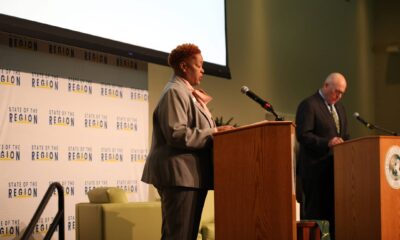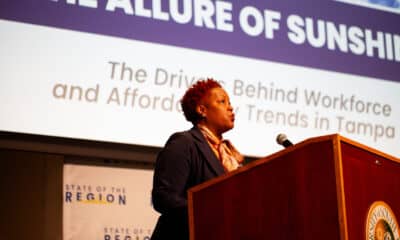Know
USF researcher: Reopening schools could increase Covid-19 hospital admissions

The principal investigator in a study that used cell phone data to track the spread of Covid-19 is warning that reopening schools in the Tampa-St. Petersburg area could lead to increased Covid-19 cases at already-strained area hospitals.
“If the return to school activity in August replicates the kind of behavior in terms of mobility that we saw with Phase 2 reopening and Memorial Day type of behaviors, then we would expect a dramatic increase in hospital admissions within three weeks,” said Matt Mullarkey, director of the Doctor of Business Administration program at University of South Florida’s Muma College of Business.
Mullarkey is principal investigator of a study, dubbed Project ASPeCT, that uses anonymous mobile device data and admission data from 52 hospitals in 13 counties in and around the Tampa Bay area. The project found a strong relationship between hospital admissions and mobility — the distance people traveled, the unique locations they visited, and the number of other people at those locations.
Florida was under a statewide stay at home order during most of April, and there were limited hospital admissions — about 20 a day — through the end of May, as the effects of that order lingered, Mullarkey said during an online community forum Wednesday hosted by the Tampa Bay Partnership.
But as the state moved into the first phase of a three-phase plan to reopen businesses, there was an uptick in mobility, and within about three to four weeks after the start of Phase One, hospital admissions doubled from 20 a day to 40 a day, he said.
Most of the state moved into Phase Two of the reopening plan in early June.
“The Phase 2 openings – specifically Memorial Day’s effect followed by Phase Two reopenings – was a signal that represented a dramatic increase in mobility and it took about three weeks but by the early part of July we have seen our total daily admits double again, from 40 to 80, and then double again, to over 160 on average for the last three weeks,” Mullarkey said. “Every little increase in mobility is having an accelerated increase in the number of admissions, and the rate of increase in hospital admissions has grown dramatically and put incredible pressure on our hospital system.”
The study also found that requirements for face coverings have had a dampening effect on mobility.
“When public officials come out strongly with recommendations in this space …. We can see a dramatic reduction in mobility,” he said. “We don’t know if people chose to wear masks or not, but we do know that people took that input and modified their behavior in ways that improved the safety of us all and dramatically reduced the probability of the spread of the virus.”
Rick Homans, Tampa Bay Partnership president and CEO, asked Mullarkey about the implications of the study for local schools, as they prepare to reopen next month.
“If we replicate that kind of Phase Two opening behavior – which is very possible if we don’t modify our behavior with the return to school – then we would see a doubling again in terms of the kind of admission pressure in our hospitals for Covid-19 patients,” Mullarkey said.
In-person schooling means additional mobility, he said.
“Students will be on buses, parents will drive kids to schools, college kids will transport themselves to campus, and that will have a significant. increase in mobility. The question is, does that mobility come with the same risk of spread? And barring significant social distancing behaviors and other hygiene-related behaviors, we understand that the mobility relationship to admissions will drive admissions up.”
No policy decision during the pandemic has been easy and schools are just another example, said Dr. Marissa Levine, director of the Center for Leadership in Public Health Practice at USF Health.
“I think the challenge locally is we still have widespread community transmission. That puts everyone at risk as you increase mobility and the likelihood of teachers and staff bringing Covid into a situation which could become a super-spreader event increases,” Levine said at the Partnership forum.
“I’m all for helping us learn how to live with Covid. We are likely going to have to live with Covid for maybe a year or so … And I think there are ways that children can get back to school and quite frankly need to get back to school because we see disparate educational outcomes from what’s going on,” Levine said. “But I think that right now with widespread transmission we have to be really careful to make sure we’ve done everything with respect to the hierarchy of controls that the business community understands to make sure we have safe environments. And I think that doing so during widespread transmission in a community — particularly without being fully prepared — is very risky.”
Maintaining maximum social distancing in classrooms should be mandatory, Mullarkey said. Wolfgang Jank, the Anderson Professor of Global Management in the School of Information Systems and Management at Muma College of Business, said reducing density, or the number of people in the classroom, also would help.
“There’s a predetermined size in many of our spaces, although classroom sizes can be changed. If we can manage to change the density in the classrooms, that might be one approach to get more safely back to school,” Jank said.
Knowing there is a direct correlation between mobility and hospitalizations, Mullarkey is urging area residents to avoid discretionary travel.
“There will be a need to go to work. There will be a need perhaps to go to the grocery store. But avoid anything that is discretionary. Minimize the number of people you come into contact with. Keep your circle as tight as possible,” he said. “And if you have to be in a location where you don’t have control over the number of people, whether a classroom, a retail outlet or a workplace, you must follow the hygiene factors, you must wear a mask and you must wash your hands. We know those three activities will lead to a dampening of the spread and a reduction in the pressure on hospital admissions.”







